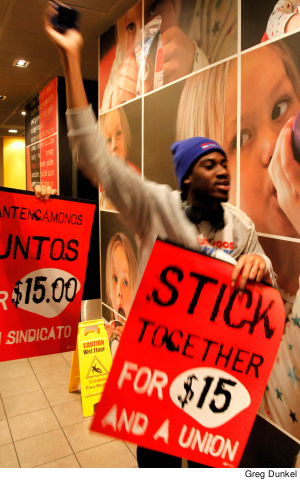Mayor-elect Bill de Blasio swept into office as a relentless critic of the widening divide between the haves and have-nots, with his much-mentioned “tale of two cities.” Two years earlier, Occupy Wall Street had catapulted the issue of economic inequality, formerly an obscure preoccupation of policy wonks and academics, to the center of the national political conversation. But while its success revealed the issue’s broad political appeal, the meteoric Occupy movement never faced the actual challenges of governing. In that regard, our new mayor has his work cut out for him.
 |
In New York City, as in the nation, inequality has soared to levels not seen since the first Gilded Age more than a century ago. Working people – especially the non-college- educated – have steadily lost economic ground in recent decades, and the labor movement has been reduced to a shadow of its former self. This devolution began in the aftermath of the fiscal crisis of the 1970s, was accelerated under the Rudy Giuliani and Michael Bloomberg regimes, and has been further aggravated by the Great Recession.
New York remains the nation’s most highly unionized large city, with union density (the proportion of wage and salary workers who are union members) roughly double the national average. Yet New York City also has higher levels of income inequality than any other city in the US, reflecting a highly polarized pattern of workforce growth. Both before the 2008 crash and during the still-anemic recovery, low-wage service industries like retail and restaurants have expanded rapidly, along with domestic work and day labor. At the other end of the labor market, well-paid professional, managerial and technical jobs – especially but not only in the financial sector – have proliferated. In sharp contrast, the “middle class” is virtually an endangered species.
That is the dynamic underlying the tale of two cities, driving not only income inequality but also the vast disparities in access to housing, education and health care that mark New York City in the 21st century.
Shrinking Unions
Among the primary causes of the erosion of the middle class is union decline, especially in the private sector. Although the downward trend looks modest relative to that in the nation as a whole, private-sector union density in New York City has fallen sharply: as recently as 1986, it was 25%, nearly twice the current level (14%). Private-sector de-unionization began long before the Great Recession, but has accelerated since 2007. By contrast, public-sector union density in New York has been stable and actually rose slightly after 2007; it is currently 72%. Indeed, the gap between the city’s public- and private-sector unionization rates is at a record high, putting the public-sector unions at growing risk of political isolation, as non-union low-wage work continues to expand. This complicates one of de Blasio’s immediate challenges, namely that nearly all the city’s public-sector workers have been working under expired contracts for several years.
Unionized workers are the core of what remains of the city’s shrinking middle class. They have lost ground in recent years relative to top earners, yet even with the stagnating pay levels that have resulted from the impasse in collective bargaining under Bloomberg, they remain privileged vis-à-vis the vast numbers of low-wage non-union workers, who are somehow surviving in this evermore expensive city on pay at or near the minimum wage. De Blasio must address their needs too, an even greater challenge than negotiating new municipal union contracts.
In this regard he might take inspiration from a city at the other end of the country, San Francisco. Over the past decade, San Francisco has been a trailblazer: it has adopted a strong living-wage law; “pay-or-play” health insurance requirements for city contractors; and a paid sick days ordinance far more extensive (and with fewer carve-outs) than the one that the New York City Council finally adopted during the mayoral campaign. San Francisco also has as a city-specific minimum wage of $10.74 an hour, indexed to inflation. Contrary to the claims of business advocates, these measures have not been “job killers”; indeed, employment has expanded in San Francisco in recent years. The de Blasio administration should promote similar initiatives here to establish a decent wage floor at the bottom of the labor market.
Another policy aim should involve reversing the long-term trend toward privatization of public services. The available evidence suggests that over the long term privatization does not save taxpayers money – on the contrary. Moreover, pay, benefits and job quality typically deteriorate when work moves from the public to the private sector (often becoming de-unionized in the process).
Progressive Path
Finally, there is an urgent need to expand labor market opportunities for new labor market entrants – recent high school and college graduates who currently face job prospects more dismal than any time since the 1930s. De Blasio should create additional opportunities along these lines, perhaps with an AmeriCorps-like initiative for NYC. Vocational training leading to placement in city jobs for recent high school graduates should also be high on his agenda.
The vast inequalities that exist in today’s New York City have been long in the making, and they will not be reversed overnight. But the new mayor could lead the way forward with initiatives like these, and put the city back on the progressive path it followed for much of the 20th century.
______________________________
Ruth Milkman is professor of sociology at the CUNY Graduate Center and academic director of the Murphy Labor Institute in the School of Professional Studies.

